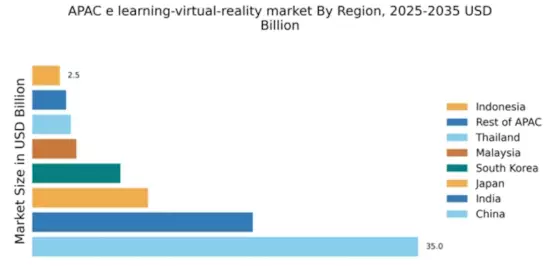China : Rapid Growth and Innovation Hub
Key markets include major cities like Beijing, Shanghai, and Shenzhen, where tech-savvy populations drive demand. The competitive landscape features significant players like Tencent and Alibaba, alongside global giants like Meta and Google. Local dynamics are characterized by a strong emphasis on innovation and collaboration between educational institutions and tech companies. Industries such as K-12 education and vocational training are increasingly integrating VR solutions to provide practical, hands-on experiences for learners.
India : Diverse Market with High Potential
Key markets include metropolitan areas such as Bengaluru, Mumbai, and Delhi, where a tech-savvy youth demographic is prevalent. The competitive landscape is vibrant, featuring local players like Byju's and Unacademy, alongside international firms like Microsoft and Google. The business environment is conducive to innovation, with a growing number of partnerships between educational institutions and tech companies. Sectors like higher education and skill development are increasingly leveraging VR for enhanced learning outcomes.
Japan : Cultural Embrace of VR Education
Key markets include Tokyo, Osaka, and Yokohama, where educational institutions are increasingly adopting VR solutions. The competitive landscape features major players like Sony and Panasonic, alongside global firms like Google and Microsoft. Local market dynamics are characterized by a high level of technological adoption and a focus on quality education. Industries such as language learning and vocational training are particularly active in integrating VR technologies to provide immersive learning experiences.
South Korea : Strong Government Support for VR
Key markets include Seoul and Busan, where educational institutions are at the forefront of adopting VR solutions. The competitive landscape features local giants like Samsung and LG, alongside international players like Meta and Google. The business environment is characterized by a strong emphasis on innovation and collaboration between educational institutions and tech companies. Sectors such as K-12 education and higher education are increasingly leveraging VR technologies to provide immersive learning experiences.
Malaysia : Strategic Initiatives Boosting Market
Key markets include Kuala Lumpur and Penang, where educational institutions are increasingly adopting VR solutions. The competitive landscape features local players like Multimedia University and international firms like Google and Microsoft. The business environment is conducive to innovation, with a growing number of partnerships between educational institutions and tech companies. Sectors such as higher education and vocational training are particularly active in integrating VR technologies to enhance learning outcomes.
Thailand : Cultural Shift Towards Digital Learning
Key markets include Bangkok and Chiang Mai, where a tech-savvy youth demographic is prevalent. The competitive landscape is vibrant, featuring local players like Learn Corporation and international firms like Google and Microsoft. The business environment is conducive to innovation, with a growing number of partnerships between educational institutions and tech companies. Sectors like higher education and skill development are increasingly leveraging VR for enhanced learning outcomes.
Indonesia : Digital Transformation in Education
Key markets include Jakarta and Surabaya, where a tech-savvy youth demographic is prevalent. The competitive landscape is vibrant, featuring local players like Ruangguru and international firms like Google and Microsoft. The business environment is conducive to innovation, with a growing number of partnerships between educational institutions and tech companies. Sectors like higher education and skill development are increasingly leveraging VR for enhanced learning outcomes.
Rest of APAC : Varied Growth Across Sub-Regions
Key markets include cities like Singapore and Manila, where educational institutions are increasingly adopting VR solutions. The competitive landscape features a mix of local and international players, including Google and Microsoft. The business environment is characterized by diverse market dynamics, with varying levels of technological adoption and regulatory support. Sectors such as higher education and vocational training are particularly active in integrating VR technologies to provide immersive learning experiences.


















Leave a Comment